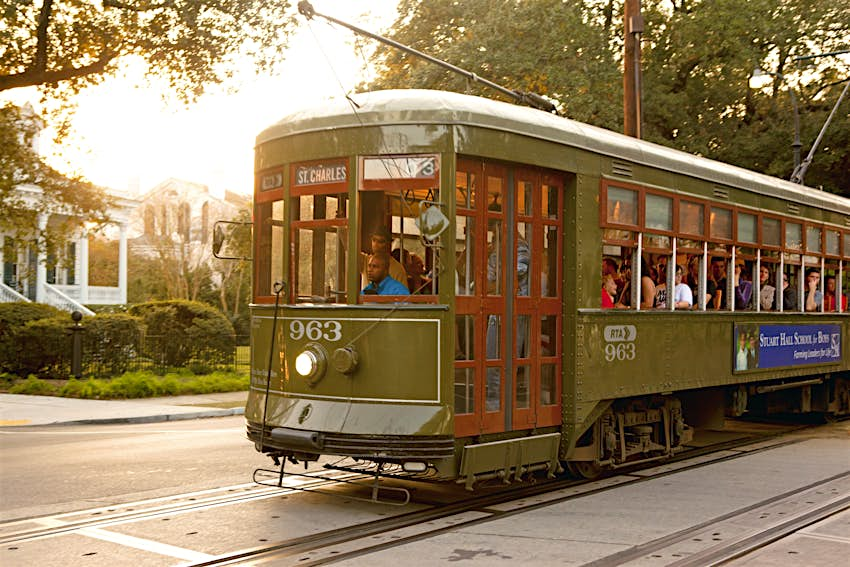Who Lives In The Garden District In New Orleans

The Garden District of New Orleans is the sort of neighborhood that lives up to its name. This is a good thing (no one wants to visit the "Rusty Junkpile District," after all), both for residents and visitors.
Here you'll find spreading live oak trees and shaded lanes, whirring streetcars and college students on a stroll, mansions and apartment buildings that resemble mansions and the sort of businesses that serve all of the above. As New Orleans goes, there are few areas that are as pleasant.
- Editor's note: during COVID-19 there are restrictions on travel and opening hours may vary. Check the latest guidance in New Orleans before planning a trip, and always follow local health advice.
The area is part of uptown New Orleans, although it is not part of the somewhat confusingly named actual neighborhood of Uptown, which sits nearby. In New Orleans, the Mississippi River acts as a constant compass, and in this case the 'up' means 'upriver', as opposed to 'downtown,' down river neighborhoods like the French Quarter. The Quarter was settled by the first Creole (French and Iberian) settlers in the city, whereas the Garden District was founded by Americans who arrived in the early 19th century who consciously distanced themselves from Francophone New Orleans.
New Orleans Is Always a Good Idea
We mention all of the above because while the French Quarter is the most iconic neighborhood in the city, as far as tourism goes, the Garden District more or less runs in second place. This is fancy New Orleans; in the past that meant this was where you'd find some of the city's most opulent mansions. In the 21st century you'll still find the same mansions, but mixed in among them are the more contemporary signposts of wealth like yoga studios and localvore fine dining.
Top things to do in the Garden District
St Charles Avenue
This street, one of the most beautiful urban thoroughfares in the country, forms the northern border of the neighborhood. All along its length, St Charles is fronted by a grand assemblage of mansions; it is hard to beat for either the number of grand historic homes or for the beauty and variety of their architecture. The best way to see St Charles is on the dark green streetcars that trundle the length and breadth of the Garden District. You can also, like hundreds of locals, jog along the 'neutral ground' (the median) that divides the street and houses the streetcar tracks. Protip: Prytania Street, which runs parallel to St Charles, is also packed with gorgeous historic homes.

Magazine Street
Magazine is the southern border of the Garden District, and while it may lack enormous, opulent homes, it makes up for them with a slew of businesses that largely cater to the ritzy and college students who haven't quite made it to ritzy. After Hurricane Katrina this commercial area was famous for being almost entirely made up of independent boutiques. But rising property values, rents and taxes mean that chains are making their presence known on Magazine, although indie businesses dominate for the time being. Houses here are smaller than around St Charles - this is because the old plantation mansions parceled off their enormous gardens into residential lots, which is, incidentally, how the neighborhood got its name.
Lafayette Cemetery No. 1
Because of its low elevation and high water table, corpses in New Orleans were traditionally 'buried' in 'cities of the dead' full of raised tombs and mausoleums. Of all the iconic graveyards in New Orleans, few can match the sheer gothic creepiness of Lafayette No. 1, which runs rampant with creeper vines and vegetation. The rot of the plants underlines the prevailing theme of death, yet at the same time the fecundity of the area contrasts the presence of so many expired citizens.

Best places to eat and drink in the Garden District
The Garden District technically ends at Magazine St and St Charles Ave; we include a few businesses here and in the hotel section that fall a few blocks outside of those borders because they are A) awesome, and B) so close to the District the difference is negligible.
Stein's Deli
The po'boy is the iconic New Orleans sandwich, yet if you're looking for something delicious between two pieces of bread, it's hard to beat this cramped deli on Magazine St. This is classic Northeast lunch counter fare - reubens, corned beef specials, Italian hoagies, etc - served alongside refrigerators full of good beer, by a staff that brooks no nonsense. The ordering procedure may feel weird on crowded days (most days); just find the line, get in the back, and order with confidence.
Verret's Lounge
In a neighborhood that is understandably considered fancy, Verret's is a grungy dive bar where youngsters rub elbows with grizzled regulars and everyone has a good time. It's small and cozy and unassuming, which in and of itself is refreshing and almost groundbreaking in a country where it feels like another craft cocktail bar opens every five minutes.. Located two blocks outside of the Garden District.
Poke Loa
Poke (a bowl dish that usually consists of rice, vegetables, and protein, often fish, mixed with marinades and optional extras) is hardly traditional New Orleans cuisine, but it is increasingly popular, seeing as it sits somewhere between the juncture of healthy eating, superfoods, and gluten free. It's also delicious, and Poke Loa, popular with students and a business crowd, is a great spot for a fix.

Commander's Palace
New Orleans is famous for grand dame fine dining temples to Creole cuisine, which blends the sauce-y richness of French gastronomy with African and Native American techniques and local ingredients. Of all the legacy restaurants in the city, few have the sheer institutional presence of Commander's. Housed in a turquoise and white mansion you could probably recognize from space, this enormous white-linen dining hall has served generations of New Orleanians looking to indulge the city's signature rich gastronomy. Well, that and the 25-cent martini lunch special, which go a long way towards prepping you for more indulgence.
The Bulldog
Popular with Tulane students and alumni, doctors and suits getting off work, and really anyone who likes a good beer, the Bulldog boasts dozens of varieties of brew served in an easy-going atmosphere. The big draw is a courtyard complete with a fountain formed from a long row of beer taps.
Best places to stay in Garden District
Sully Mansion
This beautiful, tidy bed and breakfast is a quintessential Garden District stay - not only for the quality of the accommodation, but the sheer upscale-casual aesthetic. If you want to sleep in, and not just gawk at, local mansions, the Sully, with its wedding cake design, garden, breezy terrace and enormous wraparound porch, is what you've been looking for.

Henry Howard Hotel
Located just east of the Garden District, the Henry Howard occupies the space of an 1867 double gallery townhouse, since converted into a hotel that nicely balances exposed brick historical vibe with a minimalist chic design sensibility. Located within easy walking distance of the more lively nightlife scene of the Lower Garden District (the next neighborhood over from the Garden District, so named because it is further downriver).
Hotel Indigo New Orleans Garden District
The Garden District doesn't have many high volume hotels, but this branch of the self-consciously bohemian Indigo boutique chain scratches the itch. Decor reflects a blend of New Orleans iconic photography with the Indigo's signature contemporary-for-everyone design palette. Notably, this is a pet friendly business, which can be rare when it comes to New Orleans hotels.
You might also like:
Buy the Ultimate Travel List

The second edition of Lonely Planet's bestseller presents an all-new ranking of the greatest places to visit on Earth.
Who Lives In The Garden District In New Orleans
Source: https://www.lonelyplanet.com/articles/garden-district-new-orleans-guide
Posted by: goodwinhatiou.blogspot.com

0 Response to "Who Lives In The Garden District In New Orleans"
Post a Comment